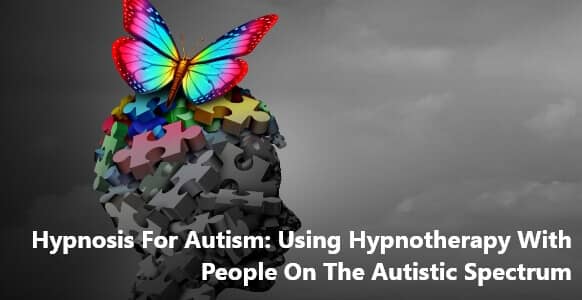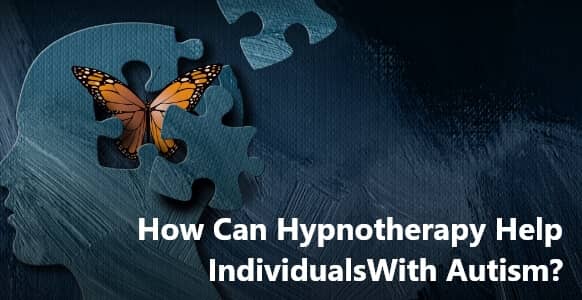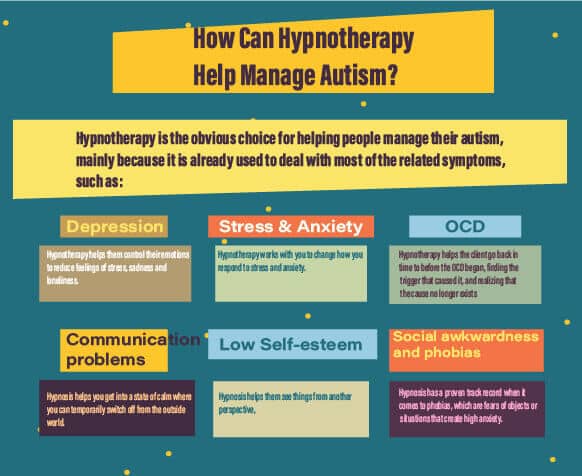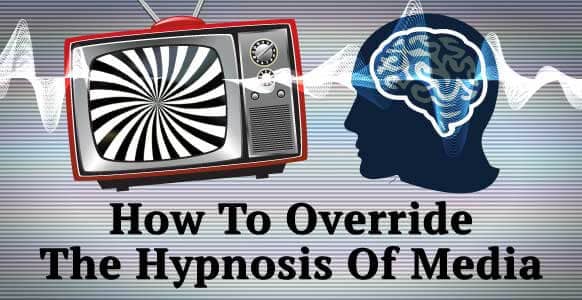
When it comes to autism, hypnosis or hypnotherapy might not be the kind of therapeutic method that springs to mind.
But the more you think about it, the more sensible it becomes.
Why? Because people with autism are just like the rest of us.
They experience anxiety, stress and low self-esteem.
They struggle to communicate their precise needs at times.
They develop coping strategies to deal with the pressures of life and the possibility of being misunderstood.
But autism isn’t a disease: it’s just a different way of thinking.
That’s why hypnosis for autism makes sense. It’s the perfect technique to help anyone manage stress, anxiety or depression.
Hypnotherapy gives you the tools to relax and live a calmer and happier life.
It’s the ideal antidote for turning negative thoughts into positive ones, and for helping to focus on your strengths rather than on your weaknesses.
Whatever challenges or problems you might face in your daily life, hypnosis is the key to unlocking possible solutions.
And because it is a totally safe and non-invasive form of therapy, using it to help manage the symptoms of autism seems like a no-brainer.
But is it appropriate for anyone at any age, or does the technique come with certain limitations?
How Can Hypnotherapy Help Individuals With Autism?

One of the reasons why hypnotherapy is so effective is because it helps in the treatment of the individual, and not just a set of symptoms.
Just as every person is unique, so is every person on the autistic spectrum. What they have in common, however, is the way they respond to certain situations.
Writing in the Autism Parenting Magazine, hypnotherapist Janel Dowling notes that the fight or flight response can be triggered much more easily in people with autism.
For example, suppose you’re going for a job interview and you haven’t prepared yourself properly. You’re bound to be nervous, your pulse will speed up, your palms will start to sweat, you’ll forget what you wanted to say and you’ll feel sick to your stomach.
However, it takes a lot less to arouse the same level of stress and anxiety in a person with autism. They can experience these physical responses when there’s an unexpected interruption in their routine, or when something they enjoy is suddenly unavailable to them.
While it might seem trivial to onlookers, to the anxious brain of an autistic person it’s perceived as threatening.
Hypnosis helps you to enter a state of deep relaxation, and when you’re in that state your mind is more susceptible to suggestions.
People enter a hypnotic state several times a day, when they daydream, for example. It can happen when you’re doing some mundane tasks that require very little attention, such as driving a car or doing the dishes.
Many autistic individuals have the ability to relax when they’re involved in something they love doing.
As well as helping you to relax, hypnotherapy also stimulates the imagination. And since autistic people are able to think in pictures, this kind of therapy is particularly suited to their needs.
People with autism can be given various coping mechanisms that they can practice at home, such as deep breathing or distraction techniques.
Dowling points out that breathing techniques can help to calm down the amygdala, the part of the brain that regulates emotion. When emotions are able to be calmed down, it helps the person feel like they’re in control again.
Techniques like these could help autistic individuals function in situations that might otherwise cause stress or severe anxiety.
Is Hypnotherapy Safe And Advisable For Children?
Hypnosis is a natural state of relaxation that everyone experiences several times a day. It happens when you get so involved in doing something that you become oblivious to everything else around you.
It’s been described as a semi-awake state where your mind is focused while your critical factor is temporarily switched off. Another name for it is daydreaming.
Studies also show that hypnotherapy is highly effective in helping children overcome a wide range of issues. There are even hypnotherapists specializing in children as young as 2 or 3 years old.
No matter what age you are, you cannot be hypnotized unless you want to and unless you agree to it (or in the case of infants, unless their parents or guardians agree to it). Hypnosis is one of the few therapies that is completely non-invasive and totally harmless.
No one has ever failed to come out of a hypnotic trance, which is after all a natural state anyway. And no one can be made to do anything under hypnosis that is against their moral code.
When used for hypnotherapy, the hypnotic state is one of calm and relaxation. Most practitioners also work hard to ensure their clients that they will be safe at all times during the session.
Hypnosis is really just another form of communication between the hypnotist and the client. In order for the session to be meaningful and useful, the client has to agree to participate and follow simple instructions.
For that to happen, the hypnotherapist has to build rapport and gain the child’s trust.
The type of session will depend on a number of factors, such as the age of the child and the reason for their visit. In many cases, the therapist may use the notion of play to make the child feel more comfortable and at ease.
Their ultimate aim will be to get the child into a relaxed state in order to create emotional and therapeutic changes.
It goes without saying that any hypnotherapist that works with your child should be trained in hypnosis and should be qualified to work with children.
How Can Hypnotherapy Help Manage Autism?

The important thing to remember about autism is that it is a spectrum on a sliding scale. That means that one person might have a mild form of autism and hardly be aware of it, while another could experience intense and severe symptoms.
Some autistic people are described as high functioning. That means they are able to function normally in society, hiding or disguising their autistic traits from others.
This Very Well Mind article states that, in this context, high functioning refers to how well a person is able to:
- Hold down a job
- Form relationships and keep them
- Communicate successfully with people at various levels
Research suggests that such famous figures as Michelangelo and Albert Einstein were probably on the autistic spectrum. It’s a well-known fact that the Swedish activist Greta Thunberg is autistic, suffering from both OCD and Asperger’s.
An article on the Applied Behavior Analysis site notes that Thunberg has an above-average intellect that allows her to think outside the box. She is also an excellent speaker and has a unique approach to problem-solving.
Of course, many people with autism struggle to make sense of the world and to be active participants in it. And since not all autistic people are the same, you need a flexible and adaptable process that can be tailored to suit each person. That’s where hypnotherapy for autism comes into the equation.
Hypnosis is the obvious choice for helping people manage their autism, mainly because it is already used to deal with most of the related symptoms, such as:
- Depression
- Stress & anxiety
- OCD
- Communication problems
- Low self-esteem
- Lack of confidence
- Social awkwardness & phobias
Take a look at how hypnosis and hypnotherapy helps people cope with each of these issues.
Depression – there are lots of reasons why people can feel depressed. Where autism is concerned, this might be due to social isolation, whether real or imagined.
Someone who is depressed will experience a number of different and sometimes conflicting emotions. As noted in this Healthline article, hypnotherapy helps them control their emotions to reduce feelings of stress, sadness and loneliness.
The technique also helps them tackle behaviors that could be making their depression worse, such as poor eating habits, alcohol or substance abuse, or lack of quality sleep.
[Note: If a person has been diagnosed as clinically depressed by their doctor, you will likely need permission from the doctor to work with them. Please check medical laws in your area.]
Stress & anxiety – every hypnosis session begins by getting you relaxed, which is of course the opposite of being stressed. Hypnotherapy works with you to change how you respond to stress and anxiety.
It does this by letting you go inside yourself and helping to reprogram your brain. When you do that, you’re able to take back control of your life.
An article on Very Well Mind notes that hypnosis can help deal with stress management in two ways:
- By encouraging relaxation. You can’t be relaxed and stressed at the same time.
- By encouraging lifestyle changes. If you can reduce the amount of stress you normally have to deal with, your life will automatically be less stressful.
OCD
This refers to obsessive thoughts or compulsive behaviors, which may be due to emotional or developmental issues. One powerful hypnosis technique often used to tackle OCD is regression therapy.
This helps the client go back in time to before the OCD began, finding the trigger that caused it, and realizing that the cause no longer exists. It might be necessary to get a medical doctor’s referral before working with someone suffering from OCD. If you’re unsure, check the laws or regulations in your local area.
Communication problems
If you’re constantly feeling under stress or on edge, then communicating is going to be a challenge. The trick is to slow down, relax and take your time.
Hypnosis helps you get into a state of calm where you can temporarily switch off from the outside world. That gives you a chance to organize your thoughts and even rehearse what you’re going to say in the future.
Low self-esteem
Self-esteem is the way you see yourself or the way you think others see you. Someone with low self-esteem has had the confidence sucked out of them and might feel they’re worthless.
There are a bunch of hypnosis techniques that can help boost self-esteem. For instance, Mind Bending Language is a fantastic tool for shaking up a person’s reality and helping them see things from another perspective.
Lack of confidence
In order to feel confident you must be able to trust and believe in yourself. Hypnotherapy can help turn negative thoughts into positive ones and eliminate self-doubt.
There are many confidence-boosting techniques in the hypnotherapy arsenal. Regression can be used to take you back to a time before you lost confidence, to discover the source of the problem and realize it’s no longer relevant.
Revivification is another tool that will enable you to relive a time when you were full of confidence, helping you take that feeling back into the present with you.
Social awkwardness & phobias
Hypnosis has a proven track record when it comes to phobias, which are fears of objects or situations that create high anxiety. It’s not just the thing or situation that makes you afraid: it’s also the way fear makes you feel.
Again, there are several hypnotherapy techniques that can help. One is desensitization, breaking the fear down into a series of steps from the least to the most frightening and using relaxation techniques to deal with each step calmly.
Another is the Rewind Technique, in which the hypnotist gets the person to imagine watching a movie of themselves experiencing the phobia in the past. They then “rewind” the movie to a safe point, then fast forward, repeating the process until the person feels no emotion about it.
Hypnosis For Autism: Clinical Trials & Proof
In the article “Symptoms as Solutions: Hypnosis and Biofeedback for Autonomic Regulation in Autism Spectrum Disorders,” Dr. Laurence Sugarman outlines a model that helps individuals take some control over their fight or flight response.
Sugarman’s method uses computer biofeedback and clinical hypnosis to teach children how to turn down this response and turn up the opposite. He adds that instead of trying to change the symptoms, you need to recognize the symptoms as a way to deal with what he calls “inner turmoil”.
Other researchers are working on the application of hypnosis techniques for use with autism, including relaxation, deep breathing and visualization (Mahari, 2006 et al). And hypnosis has already been used with children for a variety of dental, medical, educational, psychological and behavioral conditions (Olness & Kohen, 1996).
This Library of Medicine article recognizes the benefits of hypnosis as a teaching tool that helps young people develop the skills they need for self-regulation.
While it is generally understood that much more research still needs to be done, the case for using hypnosis to help manage autism in people of all ages remains a strong one.
Conclusion & Key Takeaways
Autism isn’t a disease: it’s a different way of thinking.
People with autism experience stress, anxiety and low self-esteem just like everyone else.
Hypnosis and hypnotherapy give autistic people the tools they need to relax, stay calm and manage their symptoms more effectively.
These techniques help them stay positive so they can focus on their strengths rather than their weaknesses.
They’re equally effective on children with autism too, specifically because hypnotherapy helps to stimulate the imagination. And autistic people are able to think in pictures, so this kind of therapy is ideally suited to their needs.
Children with autism are taught various coping mechanisms they can use at home. The mechanisms will vary according to the child’s age and the severity of their condition.
Hypnosis is completely safe for use with children since everyone enters a hypnotic state naturally many times in a given day.
Autism is a spectrum of symptoms from minimal to severe. Some people are able to carry on with a near-normal life and are known as high functioning autistics.
They’re able to hold down a job, enjoy and maintain relationships, and communicate as necessary. Meanwhile, others struggle to make sense of the world and their place in it.
Fortunately, hypnosis is already being used to deal with many of the issues that affect autistic people, such as
- Depression
- Stress & anxiety
- OCD
- Communication problems
- Low self-esteem
- Lack of confidence
- Social awkwardness & phobias
Evidence is growing with regard to the effectiveness of hypnosis in helping to manage autism, specifically with reference to techniques such as relaxation, deep breathing and visualization. It has also proven itself as a powerful tool against various psychological and behavioral conditions in children.
Most researchers agree that more work needs to be done, but that hypnosis is providing hope for the future management of autism in people of all ages.









![[ADVANCED GUIDE] How To Master Hypnotic Regression Therapy - Part I: Essential Principles To Profoundly Transform Your Subject’s Emotional Trauma [ADVANCED GUIDE] How To Master Hypnotic Regression Therapy - Part I: Essential Principles To Profoundly Transform Your Subject’s Emotional Trauma](https://hypnosistrainingacademy.com/wp-content/uploads/2016/09/hypnotic-regression-therapy-essential-principles.jpg)
![Yogic Breathing For Hypnosis: 3 Easy Techniques To Ground & Relax Your Clients Before Inducing A Hypnotic Trance [Includes Infographic] Yogic Breathing For Hypnosis: 3 Easy Techniques To Ground & Relax Your Clients Before Inducing A Hypnotic Trance [Includes Infographic]](https://hypnosistrainingacademy.com/wp-content/uploads/2019/05/yogic-breathing-for-hypnosis.jpg)



